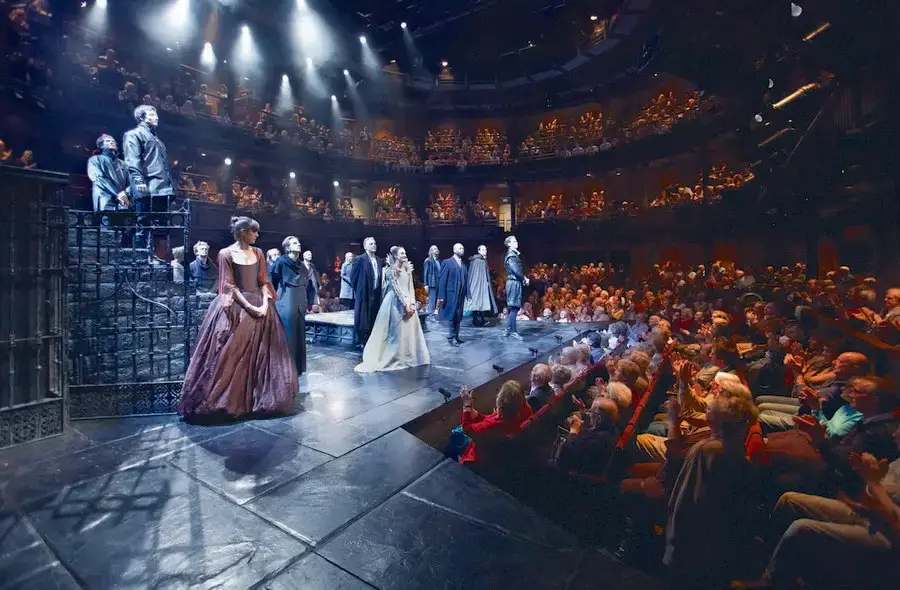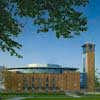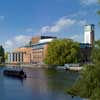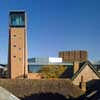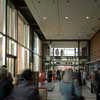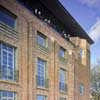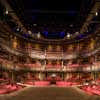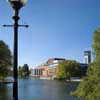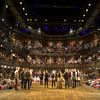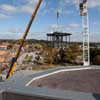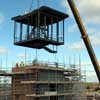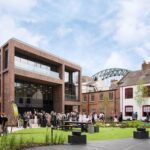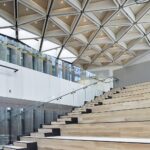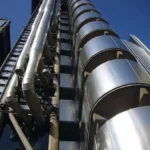Royal Shakespeare Theatre, English Arts building project photo, USITT 2012 Architecture Honor Award news, Design images
Royal Shakespeare Theatre, Stratford
Stratford-upon-Avon Building, central England design by Bennetts Associates, UK
10 Apr 2012
Charcoalblue project The Royal Shakespeare Theatre wins American USITT Award
Design: Bennetts Associates
Royal Shakespeare Theatre in Stratford-upon-Avon
UK/USA – London-based theatre design consultancy Charcoalblue’s work is clearly making waves on both sides of the ‘pond’ as the multi-award-winning transformation of the Royal Shakespeare and Swan Theatres wins the prestigious USITT 2012 Architecture Honor Award.
No stranger to this particular accolade, in 2007 Charcoalblue was delighted to see two of its previous projects, London’s Young Vic and The Unicorn Theatre, receive USITT Merit awards.
For the Royal Shakespeare Theatre (RST), Charcoalblue consultants worked in close collaboration with project architects Bennetts Associates and the Royal Shakespeare Company (RSC) project team to transform the now critically acclaimed Royal Shakespeare Theatre, Stratford-upon-Avon. RSC Artistic Director, Michael Boyd has since described it as, “a miracle of a space that combines the epic and the intimate … it’s quite extraordinary.”
Charcoalblue provided complete design and planning consultancy on the auditorium, foyers and backstage areas, as well as the design and integration of the technical systems. Managing director of Charcoalblue, Andy Hayles, who collected the award alongside Bennetts’ architect Simon Erridge and Deputy Project director for the RST, Simon Harper, says: “We’re delighted to receive the USITT Architecture Honor Award for the Royal Shakespeare Theatre.
We’re thrilled that our work has found so much favor worldwide with so many influential and respected people: the architects, the clients, our peers and most importantly the end users and audiences. The fact that our projects have also won a raft of awards and have been praised worldwide is the icing on the cake.”
Since 1994, USITT’s Architecture Awards have given public and professional recognition for contemporary architectural projects. A juried process is used to determine each year’s winners and each are given either Honor or Merit Awards. Past award winners have hailed from England, Germany, Japan, California, New York, and all points between.
You can also see Charcoalblue’s work at the V&A in London. The Prague Quadrennial exhibit features the RST and sketches by Charcoalblue’s Design Director Gavin Green.
17 Oct 2011
Royal Shakespeare Theatre Stratford Building
Architects: Bennetts Associates
Bennetts Associates Wins British Construction Industry Award
Bennetts Associates picked up the prize for Major Project for projects over £50m at the British Construction Industry Awards 2011.
More than 900 of the biggest names in the British Construction industry packed out the Great Room of the prestigious Grosvenor House Hotel, Park Lane.
The British Construction Industry Awards are the UK’s top accolade for overall excellence in building and civil engineering projects. The BCI Awards attract around 200 entries each year representing the best buildings and civil engineering projects throughout the UK ranging in size from very small to major.
BBC News presenter, Huw Edwards hosted the evening and announced the deserving winners whilst the government’s chief construction adviser, Paul Morrell, gave an enlightening speech to precede the awards. A big winner on the night was the Olympic Park Velodrome which took home the Prime Minister’s Better Pubic Building Award.
Editor of NCE, Antony Oliver said: “Our shortlist truly underlined the fine line that now exists at the top end of quality construction delivery. The good news is that, regardless of economic downturns, in the two decades that these awards have celebrated success, the bar has never been raised so high. It is a credit to you that the differentiators of 10 years ago are now the norm.”
British Construction Industry Award winner 2011
Royal Shakespeare Theatre Stratford-upon-Avon Design
Architects: Bennetts Associates
Introduction
The Transformation of the Royal Shakespeare Theatre has brought together a number of important architectural themes. At its heart, the new auditorium will revolutionise the way audiences experience live theatre. The public spaces are enticing, accessible and welcoming, and its relationship with the market town of Stratford-upon-Avon has been reinvigorated by the creation of the tower, new external spaces and routes.
The design has sensitively incorporated the most significant remains of the earlier theatres which stood on the site and retained their essential character. But the whole project is about more than just the experience of the new auditorium, or historic building conservation, or an urban masterplan, it aims to be a seamless combination of all three.
Bennetts Associates is an architectural practice with a diverse portfolio of projects which range from offices and hotels to university buildings. Before embarking on the RSC project, the practice had completed the new Hampstead Theatre in North London which opened in 2003.
Bennetts Associates has also established a good reputation for projects incorporating historic buildings such as the practice’s own offices in Clerkenwell, London and work on the Grade 1 listed Carlton House Terrace. The approach taken to historic buildings is typified by a desire to create sensitive interventions which allow the context and proportions of the original building to be revealed.
The RSC project builds on the lessons learned from these projects and on Bennetts Associates track record of urban design projects. Examples of these include Brighton Library and New Street Square in London both of which have their basis in masterplans which incorporate multiple buildings, shape the wider public realm and act as the catalyst for regeneration.
Bennetts Associates is known for its distinctive approach in which the origins of the design can be traced through detailed analysis of the issues and genuine collaboration with client, design team members and other stakeholders. Theatre itself is a highly collaborative art form and the practice’s reputation for teamwork was critical to the RSC in their selection of an architect. The resulting project team, led by Bennetts Associates, is in some ways analogous to the ‘ensemble’ of actors that are an important part of the RSC’s own creative process.
Approach
Modern theatre buildings are a reflection of the multi-faceted organisations which commission them. They are a building type which at once needs to thrill the audience, to nurture the creative spirit of the acting company and to facilitate the stealth and ingenuity of the technical team. Balancing the sometimes conflicting needs of these three groups is essential.
In this project, the constraints of a tight budget forced realistic expectations to be set early in the design process as there was little possibility of increasing the building footprint to accommodate any extension of brief. The challenge was one of maximising the value of every millimetre of space between the retained Bancroft façade and the Swan, and to celebrate the character of the resulting spaces.
The dramatic spatial quality of the foyer, the panoramic shape of the rooftop restaurant and its terraces, and the creation of a public square (accommodating both the delivery of scenery and impromptu public performance) were all the result of pre-existing site conditions and the building is stronger as a result of them.
Theatre people have a passion for the ephemeral quality of ‘found spaces’, and in the same way that theatre designers thrive on the quirkiness of a warehouse, a church or a railway station, so the RST has derived richness from the immovable elements of its own history.
The Royal Shakespeare Theatre’s progression from the original nineteenth century summer festival theatre on the banks of the Avon to the building seen today has been one of evolution rather than reconstruction. At each major point of change (the catastrophic 1926 fire leading to Elisabeth Scott’s rebuilding, Michael Reardon’s 1985 Swan Theatre for Trevor Nunn, and the latest Transformation project) significant parts of the site were left untouched, often for reasons of practicality or financial necessity rather than sentiment. The current building therefore owes its richness and complexity to these many layers of history, much of which has been retained and enhanced in the latest project.
Conceived at the height of cinema’s golden age, Elisabeth Scott’s 1932 auditorium was a vast fan-shaped room which placed the actors behind the picture-frame of a proscenium arch. The high and distant balconies and the bare side-walls created a void across which audience and actors have struggled to communicate for generations despite the RSC’s many attempts at modification.
In addition to its unpopular auditorium, Scott’s building missed the opportunity to connect with the town of Stratford-upon-Avon. At an urban level, its entrances and fine brick façades were placed to the North and East, addressing the river and Bancroft Gardens whilst a utilitarian ‘jam factory’ façade with a grid of small punched windows faced the town. Where Scott excelled however, was in the detail of the building’s public spaces which were carried out with a high level of craftsmanship using a rich palette of materials.
It was clear from the beginning of the Transformation project that major changes would be required to the existing building to create the modern, accessible theatre the RSC required. Firstly the auditorium was completely re-thought in order to create a space properly suited to the performance of Shakespeare, this meant radical rebuilding at the heart of the old theatre.
Secondly, the team looked for ways of improving the theatre’s physical relationship with the town, a masterplan was devised which identified important pedestrian routes between the Town, Bancroft Gardens, River Avon and Holy Trinity Church. These routes were then reinforced in the design of the theatre by the creation of a continuous riverside walkway, new Weston Square, the tower, the colonnade and placing new entrances to create a much more permeable building.
The tower was a deliberate reference to the tower which had existed on the site as part of the original 1879 theatre, its function was to allow visitors to take in views across the town, but also to act as a water tower for the fire brigade. Whilst it excelled in the former, it failed in the latter and was engulfed in the fire which destroyed much of the original theatre in 1926.
The new tower and the square at its base mark new entrances to the building and create important links between the theatre and the town of Stratford-upon-Avon. From its top, today’s visitors will again take in views of Shakespeare’s birthplace, his schoolroom, the site of his later house, and Holy Trinity church in which he was married and is buried. Amid all this change, the essence of Elisabeth Scott’s design remains clearly visible with its immense loadbearing brick flytower and formal entrance façade.
The stripping back of later extensions on the riverside has revealed the original brick elevation which had been obscured for 70 years, and the characteristic fan-shaped geometry of the 1932 building is still evident in the ‘kinked’ elevations to each side of the building, embracing the riverside terrace to the east and Theatre Square to the west. Inside the building the fine interiors of the foyer spaces and grand staircase have been sensitively restored.
And finally, in the heart of the building the intimate new auditorium fits comfortably within the scarred outer walls of Scott’s now demolished auditorium, leaving a triple-height void on three sides providing much-needed orientation space and a potent physical reminder of the sheer scale of the old theatre, where despite its shortcomings, so many great performances took place.
Previously:
5 Oct 2009
Royal Shakespeare Theatre Stratford, England
The landmark ‘lantern’ of Bennetts Associates’ Royal Shakespeare Theatre is lifted into place
The 32 metre-high ‘lantern’ platform, which will allow visitors to take in panoramic views across Stratford, has been positioned at the top of the Royal Shakespeare Theatre’s new tower.
The glass and steel viewing platform, which will accommodate up to 50 people, was built on the ground and lifted into place by a 300 tonne mobile crane. It will sit on the magnificent new Theatre Tower built by 8 specialist bricklayers and 6 specialist architectural metal workers from over 90,000 bricks gently ascending at a 3 degree angle. The outer walls have been built by hand over the last nine months and to do this the tower has been progressively encased in scaffolding.
Descent will be by a steel staircase that wraps around the central lift shaft, offering views through many small windows that are set in the thick brick outer walls or through the slit windows that form the corners of tower. On their descent from the top, visitors will be able to cross to the theatre where they will encounter the third floor rooftop restaurant, which will have panoramic views of the River Avon and the adjacent Bancroft Gardens.
The prominent structure was inspired by the original Memorial Theatre water tower, which was engulfed in flames when the theatre was gutted by fire in 1926. As well as becoming a significant new feature for the Royal Shakespeare Theatre (RST) itself and providing stairs and one of two passenger lifts serving all levels of the new theatre, this structure will create a new landmark for Stratford-upon-Avon. It also forms one side of the new entrance to the colonnade, which will link the RST and the Swan Theatre together for the first time.
Simon Erridge, Director of Bennetts Associates, said: “It was an exciting moment for the whole team and the result of a great collaborative effort. The size of the crowd that formed in the street below made the whole operation a piece of theatre in its own right!”
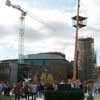
image : Bennetts Associates/ Simon Erridge
Companies involved in the construction of the Theatre Tower and lifting of the Theatre Tower ‘lantern’ include Buro Happold, Gardiner and Theobold, Drivers Jonas (RSC Project Team), plus Mace (Construction Managers) and CMF, Lesterose, Elliot Thomas (trade contractors).
Royal Shakespeare Theatre images / information received 051009
Location: Stratford-upon-Avon, England, UK
New English Architecture
Contemporary Architecture in England
English Architecture Designs – chronological list
New Chester Theatre Building, northwest England : Bennetts Associates Architects
Warwickshire Buildings – Selection:
The Royal Shakespeare Company Courtyard Theatre, Stratford-upon-Avon
Ian Ritchie Architects Ltd
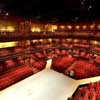
photo from Ian Ritchie Architects
Warwickshire building : photos
Bluebell Views Student Residences, University of Warwick
Page Park Architects
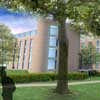
picture from architect
University of Warwick Student Residences
Comments / photos for the Royal Shakespeare Theatre English Architecture page welcome

